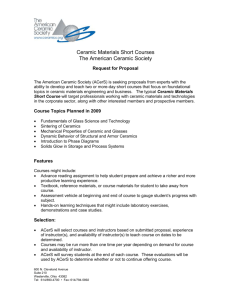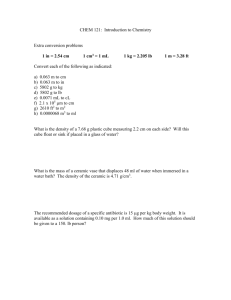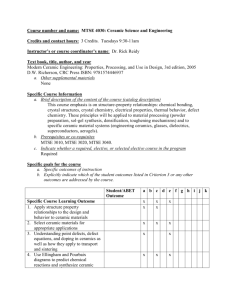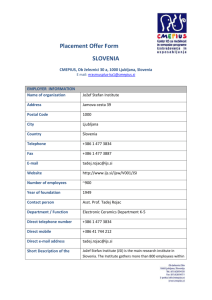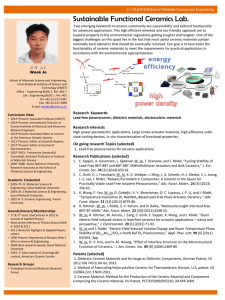Conduction & Failure Mechanisms
advertisement
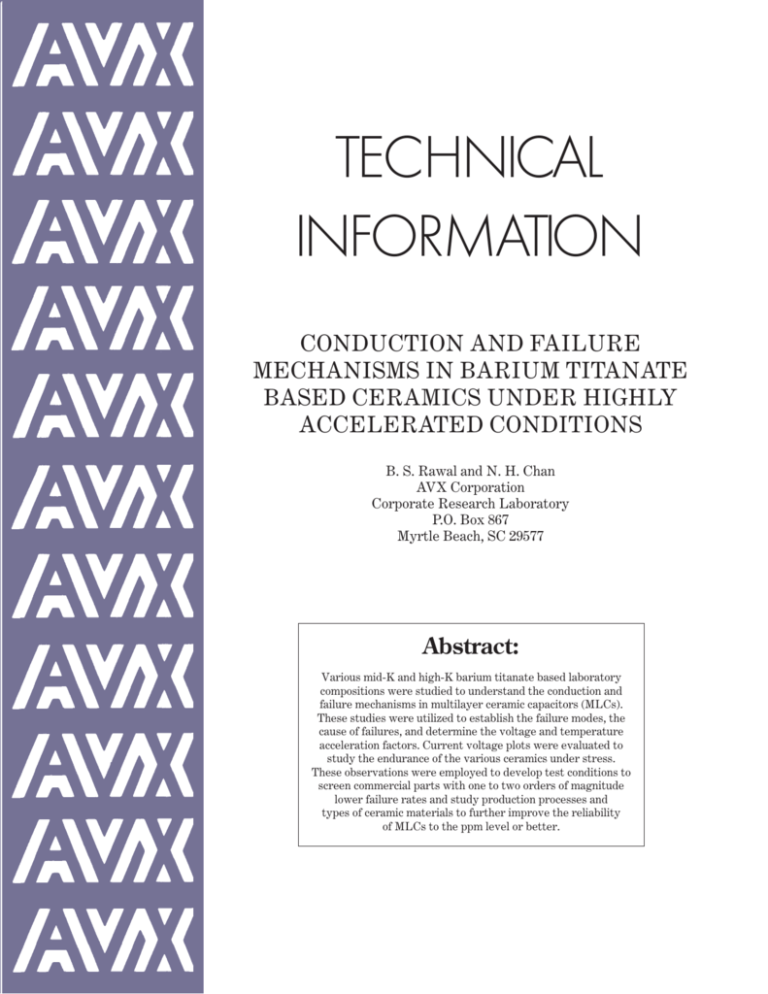
TECHNICAL INFORMATION CONDUCTION AND FAILURE MECHANISMS IN BARIUM TITANATE BASED CERAMICS UNDER HIGHLY ACCELERATED CONDITIONS B. S. Rawal and N. H. Chan AVX Corporation Corporate Research Laboratory P.O. Box 867 Myrtle Beach, SC 29577 Abstract: Various mid-K and high-K barium titanate based laboratory compositions were studied to understand the conduction and failure mechanisms in multilayer ceramic capacitors (MLCs). These studies were utilized to establish the failure modes, the cause of failures, and determine the voltage and temperature acceleration factors. Current voltage plots were evaluated to study the endurance of the various ceramics under stress. These observations were employed to develop test conditions to screen commercial parts with one to two orders of magnitude lower failure rates and study production processes and types of ceramic materials to further improve the reliability of MLCs to the ppm level or better. CONDUCTION AND FAILURE MECHANISMS IN BARIUM TITANATE BASED CERAMICS UNDER HIGHLY ACCELERATED CONDITIONS B. S. Rawal and N. H. Chan AVX Corporation Corporate Research Laboratory P.O. Box 867 Myrtle Beach, SC 29577 Summar y Multilayer ceramic capacitors prepared from various mid-K and high-K barium titanate-based laboratory compositions were studied to understand the conduction and failure mechanisms. For these laboratory ceramics, two types of failure modes, called avalanche breakdown or ABD and thermal runaway or TRA, were found. The ABD type failures were caused by extrinsic flaws such as delaminations, cracks and thin spots, and TRA type failures were attributed to intrinsic type imperfections such as electronic disorders, grain boundaries and the presence of a second phase. The voltage acceleration studies yielded voltage exponent values in the range of 2 to 4, and the temperature acceleration was best described by a pseudo activation energy for the process. Currentvoltage plots were evaluated to study the endurance of the various ceramics under stress. These observations were employed to develop test conditions to screen parts with one to two orders of magnitude lower failure rates. Employing the understanding obtained from the above studies, the control of production processes and ceramics allowed further improvement of mean time to failure by another order of magnitude. These studies thus clearly provide a means to improve reliability of MLCs to the ppm level or better. Introduction Increasing densities of capacitors on printed circuit boards are requiring further improvements in the reliability of these components. Capacitor manufacturers commonly use rated or higher voltage under low impedance conditions for evaluating capacitors, and in turn define the reliability of these parts. The desire to improve the reliability of multilayer ceramic capacitors (MLCs) to the parts per million level or better has prompted the investigation of the actual conduction and failure mechanisms of these capacitors. Minford1 and Prokopowicz and Vaskas2 have addressed the accelerated life testing of capacitors at elevated temperature and voltage but have not evaluated the conduction and failure mechanisms of the parts studied. In this paper results of various ceramics prepared in the laboratory will be reported, and these results will be used to demonstrate techniques to improve the reliability of commercial MLCs. Experimental Procedure Various mid-K and high-K barium titanate-based ceramic materials were used to manufacture MLCs using the conventional tape processes.3 Except where indicated, all samples had a dielectric thickness of 25 µm (1.0 mil). The life test and conductivity measurements were done by a continuous current monitoring technique. The leakage current of a test sample was monitored by an electrometer from which the output was recorded on a strip-chart recorder. Fifty samples were used in each test group. Results and Discussion In the following text, four sections will report the results of MLC samples prepared in the laboratory for understanding the features of various conduction and failure mechanisms. These results will then be modeled to demonstrate their actual application in producing a commercial ceramic now being used. Failure Modes Of about 1,000 samples of various ceramics tested so far, two types of failures have been observed in the dielectric. One is an abrupt burst of current which results in an immediate breakdown (henceforth referred to as avalanche breakdown, or ABD). The other failure is a much more gradual increase of leakage current which leads to self-heating and its subsequent failure (henceforth referred to as thermal runaway, or TRA). A typical current-time recording is shown in Figure 1 for ceramic A. The gradual increase of leakage current is a necessary condition for the thermal runaway process but not for the avalanche breakdown process. A large deviation from a normal distribution indicated in the figure also signifies two different failure modes. If one plots the population of each failure mode into a separate figure, one would see a normal distribution* in each case as shown in Figures 3 and 4, respectively. Each of them has a distinct mean time to failure (MTTF), and the shorter MTTF always corresponds to the group failing by the avalanche breakdown process (within statistical error) because TRA sets the upper limit. Figure 1. Leakage Current as a Function of Time Under High Temperature and High Voltage Stresses It should be noted that at very high voltages (≥ four times rated voltage) and/or at very high temperatures (≥ 140ºC), current bursts are much more prevalent in units exhibiting the avalanche breakdown process compared to units exhibiting the thermal runaway failure mode. These current bursts are postulated to result from yielding of weak spots or flaws in the dielectric. The earlier the current burst occurs, the more likely the early failure of a unit. Extensive examination of various dielectric materials at lower voltages and/or lower temperatures shows no indication or presence of any of these current bursts. Figure 3. Normal Failure Probability Plot of Ceramic A with ABD Failures Only A normal failure probability plot of a laboratory prepared ceramic A tested at 140ºC, 400 VDC is shown in Figure 2. These test conditions are highly accelerated to ease the evaluation of the parts, and the results should be carefully evaluated before making any conclusions about the reliability of these parts. Figure 4. Normal Failure Probability Plot of Ceramic A with TRA Failures Only The two failure modes, however, may not be observed at all test conditions. A higher temperature normally favors the occurrence of a thermal runaway type of failure, while a higher voltage normally favors the avalanche breakdown failure. The region of test Figure 2. Normal Failure Probability Plot of Ceramic A with Both ABD and TRA Failures *Not always the case for ABD as infant mortality may be present. conditions where these two failure modes coexist may vary greatly from one ceramic to another. Ceramic A was found to have a coexisting range at the lower ends of temperature and voltage which made it an ideal ceramic for our study. Dielectric Imperfections and Failure Modes In general, imperfections in MLCs can be grouped in two categories: intrinsic and extrinsic. The intrinsic type may include various electronic disorders, dislocations, grain boundaries, and the presence of a second phase. The extrinsic type imperfections include porosity, delaminations, thin spots, cracks, local contamination and voids. To identify the relationship between dielectric imperfections and failure modes, several experiments were designed and the following general observations were made: a. Dielectric with a higher percentage of porosity has a higher degree of avalanche breakdown and a shorter MTTF. b. Dielectric capacitors with a higher percentage of one or more of the identifiable extrinsic flaws show a higher percentage of avalanche breakdown. Within a group of capacitors failing by ABD, one may find a small group of infant mortality which usually contains major physical flaws.4 related to the test voltage, V, and temperature, T, by: t1 = V2 t2 V1 ( ) n [ exp Es/K ( T1 – T1 ) ] 1 2 where Es is the pseudo activation energy and the subscripts refer to test conditions 1 or 2, respectively. A voltage stress exponent, n, was reported as 2.7 and the pseudo activation energy, Es, as 0.90 eV for the mid-K ceramic. Minford1 found n to be 2.46 ± 0.23 and Es to be 1.19 ± 0.05 eV for a high-K ceramic. The voltage acceleration for ceramic A failed by thermal runaway is shown in Figure 5. The trend of the data does not indicate a constant slope. If a “best fit” curve is drawn, the tangent of the curve would vary from about -2 at 150 volts to about -4 at 400 volts. This suggests that a constant exponent, n, in the term (VV ) 2 n 1 is not a true representation of the voltage acceleration factor. Minford1 also saw an exaggerated acceleration at high voltage (400 volts). The non-linearity in the voltage acceleration exponent explains the reasons for the inconsistency in the values reported by various previous investigators. A value of 3 is normally accepted in the industry of ceramic capacitors. c. Dielectric materials more susceptible to the failure by thermal runaway are the materials which show a significant increase of leakage current due to a charge injection under the stresses of voltage and temperature. The injected charge carriers usually have a well-defined activation energy. For ceramic A, they were identified to be the oxygen vacancies and the detailed results have been reported earlier.5 From these observations the cause of avalanche breakdown is attributed to extrinsic flaws, and the thermal runaway process is attributed to the intrinsic characteristics of the ceramic. However, there are test conditions where all units in the group fail by thermal runaway only, and there are other test conditions where all units in a similar group fail by avalanche breakdown only. Therefore, the distinction between “intrinsic” and “extrinsic” is relative. As shown later, for example, for the commercial ceramics tested at 85ºC or 125ºC (regardless of test voltage), no thermal runaway type of failure has been observed. In this case, “extrinsic” can be considered as the infant mortality and “intrinsic” for the rest of the group. Failure Accelerated by Voltage and Temperature According to the empirical equation modeled by Prokopowicz and Vaskas,2 the mean time to failure, t, is Figure 5. Voltage Acceleration of Ceramic A Failed by TRA The acceleration by temperature is shown in an Arrhenius plot of MTTF in Figure 6. Two groups of ceramic A were evaluated here. For the failure by TRA, the pseudo activation energy is 1.87 eV for Group 1 and 1.96 eV for Group 2. For the failure by ABD, the pseudo activation energy is 1.49 eV for Group 2 and undetermined for Group 1 due to an extremely low failure population by this mechanism. These values of pseudo activation energies are much higher than any other values reported earlier. The large discrepancy is not in the accuracy of measurements, but the uncertain physical meaning of the definition of the pseudo activation energy. The MTTF cannot be described as a simple activation process which involves overcoming a certain energy barrier. It is determined from the accumulation of various degradation processes which depend on the combination of various imperfections described earlier. Therefore, the MTTF, although thermally activated, does not have a clear physical meaning as related to the activation energy at this time. This is because of the complicated nature of degradations from various imperfections. This complication resulted in a large discrepancy of pseudo activation energies from one material to the other. Even two identical lots of a material prepared at different times can produce a significant discrepancy. With a large uncertainty in value and physical meaning, it is only appropriate to call it a pseudo activation energy. 250 volts. This reversal of the trend indicates the weakness of the ceramic to withstand the stresses. Current monitored life test at 250ºC, 450 volts certainly shows that ceramic 1 is the weakest ceramic of the three. It fails by TRA with a mean time to failure of 2.3 hours, whereas ceramics 2 and 3 fail by ABD with MTTF of 24.5 hours and 36 hours, respectively. Figure 7. Conductance (i/V) as a Function of Voltage of Three Ceramics Tested at 250ºC. Dielectric Thickness was 45 µm Figure 6. Arrhenius Plot of MTTF of Ceramic A Tested at 400 VDC Current-Voltage Relationship Current-voltage measurements are commonly used to characterize the nonohmic behavior of various electronic devices such as diodes and varistors. The concept of the measurement, when applied to the dielectric at high temperatures, can provide some useful information concerning the dielectric endurance under the stress. Three mid-K dielectric materials were especially prepared in the laboratory for this study. All ingredients were the same except for a different grade related to the purity of BaTi03 used in each dielectric material. Figure 7 shows the results of current-voltage measurements at 250ºC plotted as the conductance (i/V) versus voltage. At this temperature, all these ceramics are nonohmic near the low voltage end. The trend is ohmic as the voltage is increased. However, ceramic 1 reverses the trend as the voltage exceeds Triple firings of ceramic materials 1 and 2, respectively, resulted in additional grain growth. Their conductances versus voltage are shown in Figure 8. Noticeable increase of conductance was observed in each ceramic, especially in ceramic 1. The increase of conductance suggests shorter life for these ceramics. And, indeed, ceramic 1 was found to fail by TRA with a MTTF of 0.75 hour and ceramic 2 failed by ABD with a MTTF of 21.6 hours tested at 250ºC, 450 VDC. Improvement of Reliability The knowledge generated from the accelerated life test and current-voltage study can be used to improve the intrinsic life of the ceramic capacitors and, at the same time, eliminate the extrinsic failures. To use life test or burn-in as a screening technique, first we need to establish an effective test condition. Figure 9 shows a typical normal probability plot of life test failures of laboratory sample ceramic A at 400 V, 125ºC. A clear separation of two populated groups is shown. If one does the burn-in at the condition for 1 hour and keeps the survivors, one would have a better than 90% elimination of the infant mortality. When tested at twice rated voltage and rated temperature, it is found that survivors have a failure rate of at least one to two orders of magnitude lower compared to the control lot. Table 1 shows the percentage of infant infant mortality eliminated would mean a lower failure rate for the survivors. By using life test as a source of feedback, great improvement of the ceramic body and its control of production process can be achieved. Figure 10 indicates such an improvement as a commercial ceramic derived from the understanding of the various imperfections mentioned earlier and the various types of BaTi03 materials employed in the base ceramic. An improvement of the MTTF by at least two orders of magnitude is obvious. This information, coupled with the voltage and temperature accelerated conditions, can be further used to improve the reliability to better than ppm levels. Figure 8. Conductance (i/V) as a Function of Voltage of Two Refired Ceramics Tested at 250ºC. Dielectric Thickness was 45 µm Figure 10. Normal Probability Plot of Life Test Failures of a Control Group Free of Physical Flaws, Tested at 400 VDC, 125ºC Conclusions Figure 9. Normal Probability Plot of Life Test Failures of Ceramic A Tested at 400 VDC, 125ºC GROUP # 1 2 TEST VOLTAGE (VDC) 50 (512 hrs) 100 (64 hrs) 200 (8 hrs) 0 2 4 3 10 16 400 (1 hr) 22 36 Table 1. Percent of Extrinsic Failure for Life Test at 125ºC at Various Test Voltages mortality of two groups of the laboratory prepared ceramic A lots tested at 125ºC with four voltages. The time required to eliminate the infant mortality is shown in the parentheses of each test voltage (cubic law of voltage acceleration was used.) It is seen that a higher percentage of capacitors are susceptible to extrinsic failure and a much shorter time is needed as the test voltage is increased. A higher percentage of The main emphasis of this paper is on the understanding of various conduction and failure mechanisms which can in turn be used to further improve the reliability of MLCs. Various ceramics were prepared in the laboratory, and our experiments carried out on MLCs prepared from these ceramics show that: a. Two types of failure, called the avalanche breakdown or ABD and thermal runaway or TRA, respectively, have been observed in various dielectrics. High voltages normally favor the ABD type of failure, and high temperatures normally favor the TRA type of failure. The two types of failure modes may coexist depending on the test conditions and the type of ceramic studied. b. In general, imperfections in ceramics may be classified into (i) intrinsic which include electronic disorders, dislocations, grain boundaries, etc., and (ii) extrinsic such as porosity, delamination, cracks, etc. From various experiments in these two groups, it was shown that ABD type failure is attributed to extrinsic flaws and TRA type failure is caused by intrinsic characteristics of the ceramic. c. It was also shown that the acceleration factors for voltage involve an exponent n which ranges from about 2 to about 4, and the accepted industry standard is 3. The acceleration factor for temperature may be described by a pseudo activation energy whose physical meaning is uncertain because it is a result of various degradation processes which in turn depend on the combination of various imperfections. d. Current-voltage measurements may be used to obtain useful information about the dielectric endurance under the stress. Experiments on three laboratory ceramics with BaTi03 powders of varying degrees of purity show MTTF which vary by more than an order of magnitude, and the processing conditions, such as sintering temperature, change this MTTF. e. The above information was used to obtain test conditions to screen parts which have failure rates of one to two orders of magnitude lower. In addition, information regarding the types of ceramic and the control of the production processes can be obtained to improve the MTTF by one to two orders of magnitude, and an example was shown. The above observations clearly demonstrate the importance of understanding the conduction and failure mechanisms to improve the reliability of MLCs to better than ppm level. Acknowledgments We want to thank Steve Hlis, Janice Smart, and Pam Edlin for their help in carrying out measurements during various stages of this research program. We want to especially thank Dr. Kim Ritchie for his constant inspiration throughout this program. References 1. W. J. Minford, “Accelerated Life Testing and Reliability of High K Multilayer Ceramic Capacitors,” in Proceedings of Symposium on Capacitor Technologies, Applications and Reliability, 1981, pp. 93-97. 2. T. I. Prokopowicz and A. R. Vaskas, “Research and Development, Intrinsic Reliability, Subminiature Ceramic Capacitors,” Final Report, ECOM-90705-F, 1969 NTIS AD-864068, 175 pp. 3. M. Kahn, “Multilayer Ceramic Capacitors Materials and Manufacture,” AVX Technical Information Series, 1981, 5 pp. 4. B. S. Rawal and N. H. Chan, “Failure Analysis of Multilayer Ceramic Capacitors,” in Proceedings of the Workshop on the Reliability of Multilayer Ceramic Capacitors, 1981, pp. 118-124. 5. N. H. Chan and B. S. Rawal, “Conduction and Injection of Oxygen Vacancies in BaTi03 Based Ceramics” presented at the Electronics Division Meeting, American Ceramic Society, Sept. 12-15, 1982. USA EUROPE ASIA-PACIFIC AVX Myrtle Beach, SC Corporate Offices AVX Limited, England European Headquarters AVX/Kyocera, Singapore Asia-Pacific Headquarters Tel: 843-448-9411 FAX: 843-626-5292 Tel: ++44 (0) 1252 770000 FAX: ++44 (0) 1252 770001 Tel: (65) 258-2833 FAX: (65) 350-4880 AVX Northwest, WA AVX S.A., France AVX/Kyocera, Hong Kong Tel: 360-699-8746 FAX: 360-699-8751 Tel: ++33 (1) 69.18.46.00 FAX: ++33 (1) 69.28.73.87 Tel: (852) 2-363-3303 FAX: (852) 2-765-8185 AVX North Central, IN AVX GmbH, Germany - AVX AVX/Kyocera, Korea Tel: 317-848-7153 FAX: 317-844-9314 Tel: ++49 (0) 8131 9004-0 FAX: ++49 (0) 8131 9004-44 Tel: (82) 2-785-6504 FAX: (82) 2-784-5411 AVX Mid/Pacific, MN AVX GmbH, Germany - Elco AVX/Kyocera, Taiwan Tel: 952-974-9155 FAX: 952-974-9179 Tel: ++49 (0) 2741 2990 FAX: ++49 (0) 2741 299133 Tel: (886) 2-2696-4636 FAX: (886) 2-2696-4237 AVX Southwest, AZ AVX srl, Italy AVX/Kyocera, China Tel: 480-539-1496 FAX: 480-539-1501 Tel: ++390 (0)2 614571 FAX: ++390 (0)2 614 2576 Tel: (86) 21-6249-0314-16 FAX: (86) 21-6249-0313 AVX South Central, TX AVX Czech Republic, s.r.o. AVX/Kyocera, Malaysia Tel: 972-669-1223 FAX: 972-669-2090 Tel: ++420 (0)467 558340 FAX: ++420 (0)467 558345 Tel: (60) 4-228-1190 FAX: (60) 4-228-1196 Elco, Japan AVX Southeast, NC Tel: 045-943-2906/7 FAX: 045-943-2910 Tel: 919-878-6223 FAX: 919-878-6462 Kyocera, Japan - AVX AVX Canada Tel: (81) 75-604-3426 FAX: (81) 75-604-3425 Tel: 905-564-8959 FAX: 905-564-9728 Kyocera, Japan - KDP Tel: (81) 75-604-3424 FAX: (81) 75-604-3425 Contact: NOTICE: Specifications are subject to change without notice. Contact your nearest AVX Sales Office for the latest specifications. All statements, information and data given herein are believed to be accurate and reliable, but are presented without guarantee, warranty, or responsibility of any kind, expressed or implied. Statements or suggestions concerning possible use of our products are made without representation or warranty that any such use is free of patent infringement and are not recommendations to infringe any patent. The user should not assume that all safety measures are indicated or that other measures may not be required. Specifications are typical and may not apply to all applications. © AVX Corporation A KYOCERA GROUP COMPANY http://www.avxcorp.com S-CFMB00M301-R
